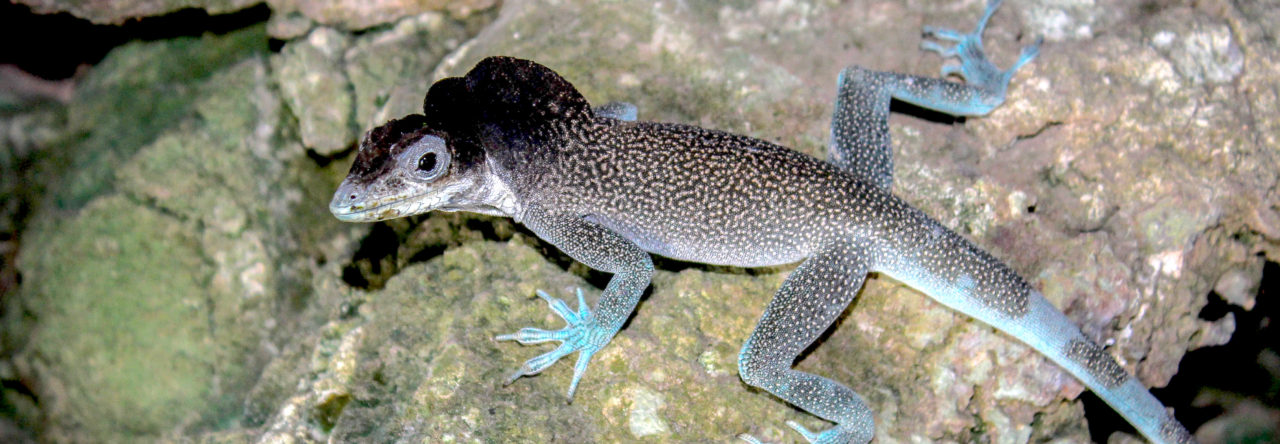
Figure 3 from Helmus and Ives (2012)
For 50 years, scientists have been cataloguing the relationship between area of islands or other patches of habitat and the number of species they contain. In general, the bigger the area, the greater the number of species. In recent years with the rise of interest in incorporating a phylogenetic perspective to all manner of questions, some have wondered how the phylogenetic variety (the degree of relatedness among species) changes with area. In an important new paper, Helmus and Ives take a theoretical perspective to understand what the expectation is for the relationship between phylogenetic diversity and area. Most excitingly, they illustrate their method using data from anoles on Caribbean islands.
Here’s how they describe what they’ve found: “While there was a strong relationship between Anolis species richness and Caribbean island bank area (Fig.3A; Losos 1996, Losos and Schluter 2000), we found no overall relationship between Anolis phylogenetic diversity and island bank area (Fig. 3B) …The greatest variation in phylogenetic diversity was associated with the overall level of in situ speciation … [T]here is a strong PDAR for the seven Caribbean island banks with at least one in situ speciation event (Fig. 4A). The estimated phylogenetic diversity values of these seven banks are dominated by in situ speciation as opposed to among-island allopatric events (Cuba had 2, 47, 49 colonizations, in situ events, species richness, respectively; Hispaniola had 4, 33, 37; Puerto Rico had 3, 11, 14; Jamaica had 1, 5, 6; Guadeloupe had 1, 3, 4; Grenada had 1, 1, 2; and St. Vincent had 1, 1, 2). The strong Anolis SAR causes a strong positive PDAR for these banks because species richness and the number of in situ speciation events positively correlate (Figs. 3A and 4B). If island assemblages were only derived from in situ speciation, then, according to the neutral macroevolutionary model we used, phylogenetic diversity is expected to positively increase, and then plateau with the number of in situ speciation events (Fig. 4C), which is the same relationship we found for the seven island banks (Fig. 4B). On at least the four Greater Antilles islands, island area sets a limit to the number of Anolis species that can arise via in situ speciation (Rabosky and Glor 2010). Thus, when there are no external colonizations that add large amounts of external evolutionary history to island assemblages, positive PDARs are expected.
It is the balance of ancestral colonizations to in situ speciation, therefore, that affects regional phylogenetic diversity. This balance is thought to be determined by a race between colonists, where initial colonist species will diversify if another colonist species does not arrive and establish too soon after the initial colonization event (Gillespie 2004). For Anolis, this balance is related to island area, the timing of island emergence and species diversification, and island isolation (Losos 2009). For example, the largest island bank, Cuba, is the center of Caribbean Anolis diversity and was likely colonized twice, by the ancestor of most Caribbean Anolis, and possibly to all Anolis (Nicholson et al. 2005), and more recently by a colonist species from Hispaniola, whose ancestor was originally Cuban (Mahler et al. 2010). Cuba thus contains a large amount of phylogenetic diversity, not because it has received outside colonists, but because it is large in area and contains old diverse lineages that have arisen via in situ speciation. Small and spatially isolated banks such as those in the lower Lesser Antilles (e.g., Grenada) have had few ancestral colonizations and few in situ speciation events that together result in low phylogenetic diversity. In contrast, species assemblages on small and non-isolated banks (e.g., the Acklins bank of the Bahamas) are completely derived from among-island colonization’s, and thus, have high phylogenetic diversity similar to the Cuban bank (Fig. 3B). Macroevolutionary simulations should thus be extended to include these isolation effects. However, the model and the Anolis data suggest that, in general, PDARs should be flat for oceanic islands whose species assemblages are an outcome of both in situ speciation and multiple colonizations.”

Figure 4 from Helmus and Ives (2012).

















